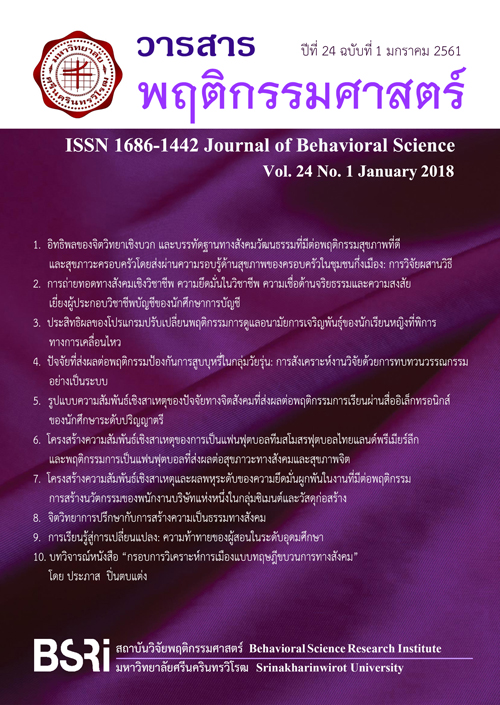รูปแบบความสัมพันธ์เชิงสาเหตุของปัจจัยทางจิตสังคม ที่ส่งผลต่อ พฤติกรรมการเรียนผ่านสื่ออิเล็กทรอนิกส์ ของนักศึกษาระดับปริญญาตรี
Keywords:
E-learning behavioral, Intention, Perceived behavioral control, Attitude toward e-learning, Social support, Achievement motivationAbstract
The purpose of this study was to empirically validate the causal relationship model of psychosocial factors affected on e-learning behavioral. The sample consisted of 360 undergraduate students who studied in Bangkok. The sample method was proportion stratified random sampling. The questionnaires were used to collect data, Cronbach’s Alpha Coefficient between 0.90 - 0.95. The data were analyzed by structured equation modeling technique. The result showed that the proposed model fitted with the empirical data (chi-square=274.63, df= 85, p= 0.00, chi-square/df= 3.23, RMSEA= 0.07, GFI=0.92, CFI=0.98, NFI=0.97). The result of path analysis showed that 1) Intention, perceived behavioral control, social support and knowledge of e-learning had positive and direct effect on e-learning behavioral (β = 0.53, 0.16, 0.30, 0.09, p < 0.05, respectively) 2) Perceived behavioral control, attitude toward e-learning and social support had positive and direct effects on Intention (β = 0.46, 0.37, 0.18, p < 0.05, respectively), 3) Achievement motivation had positive and direct effected on Attitude toward e-learning (β = 0.55, p < 0.05), 4) Perceived behavioral control, attitude toward e-learning and social support played a mediating role variable of the indirect effects between intention and e-learning behavioral (β = 0.24, 0.20, 0.09, p < 0.05, respectively) and 5) Achievement motivation played a mediating role variable of the indirect effects between attitude toward e-learning and Intention (β = 0.21, p < 0.05) and 6) Subjective norm had not positive direct and indirect effect on e-learning behavioral.
การวิจัยนี้มีจุดมุ่งหมายเพื่อตรวจสอบรูปแบบความสัมพันธ์เชิงสาเหตุของปัจจัยทางจิตสังคมที่ส่งผลต่อพฤติกรรมการเรียนผ่านสื่ออิเล็กทรอนิกส์ กลุ่มตัวอย่างคือนักศึกษาระดับปริญญาตรีในกรุงเทพมหานคร จำนวน 360 คน ทำการสุ่มตัวอย่างแบบแบ่งชั้นตามสัดส่วน เก็บรวบรวมข้อมูลด้วยแบบสอบถาม ที่มีค่าความเชื่อมั่นอยู่ระหว่าง 0.90 ถึง 0.95 และวิเคราะห์ข้อมูลด้วยเทคนิคการวิเคราะห์สมการโครงสร้าง ผลการวิจัย พบว่า รูปแบบความสัมพันธ์เชิงสาเหตุ มีความกลมกลืนกับข้อมูลเชิงประจักษ์ หลังจากการปรับโมเดล (chi-square=274.63, df= 85, p= 0.00, chi-square/df= 3.23, RMSEA= 0.07, GFI=0.92, CFI=0.98, NFI=0.97) ผลการทดสอบเส้นทางอิทธิพล พบว่า 1) เจตนาเชิงพฤติกรรม การรับรู้การควบคุมพฤติกรรม การสนับสนุนทางสังคม และความรู้เกี่ยวกับการเรียนผ่านสื่ออิเล็กทรอนิกส์ มีอิทธิพลทางตรงต่อพฤติกรรมการเรียนผ่านสื่ออิเล็กทรอนิกส์ (β = 0.53, 0.16, 0.30 และ 0.09, p < 0.05 ตามลำดับ) 2) การรับรู้การควบคุมพฤติกรรม เจตคติต่อการเรียนผ่านสื่ออิเล็กทรอนิกส์ และการสนับสนุนทางสังคม มีอิทธิพลทางตรงต่อเจตนาเชิงพฤติกรรม (β = 0.46, 0.37, 0.18, p < 0.05 ตามลำดับ) 3) แรงจูงใจใฝ่สัมฤทธิ์มีอิทธิพลทางตรงต่อเจตคติต่อการเรียนผ่านสื่ออิเล็กทรอนิกส์ (β = 0.55, p < 0.05) 4) การรับรู้การควบคุมพฤติกรรม เจตคติต่อการเรียนผ่านสื่ออิเล็กทรอนิกส์ และการสนับสนุนทางสังคม มีอิทธิพลทางอ้อมต่อพฤติกรรมการเรียนผ่านสื่ออิเล็กทรอนิกส์ โดยผ่านเจตนาเชิงพฤติกรรม (β =0.24, 0.20, และ 0.09, p < 0.05 ตามลำดับ) และ5) แรงจูงใจใฝ่สัมฤทธิ์ มีอิทธิพลทางอ้อมต่อเจตนาเชิงพฤติกรรม โดยผ่านเจตคติต่อการเรียนผ่านสื่ออิเล็กทรอนิกส์ (β =0.21, p < 0.05) และ 6) การคล้อยตามกลุ่มอ้างอิง ไม่มีอิทธิพลทางตรงและอิทธิพลทางอ้อมต่อพฤติกรรมการเรียนผ่านสื่ออิเล็กทรอนิกส์
Downloads
Downloads
Published
How to Cite
Issue
Section
License
Behavioral Science Research Institute, SWU
114 Sukhumvit 23, Bangkok 10110, Thailand.
Tel.02-649-5000 # 17600



